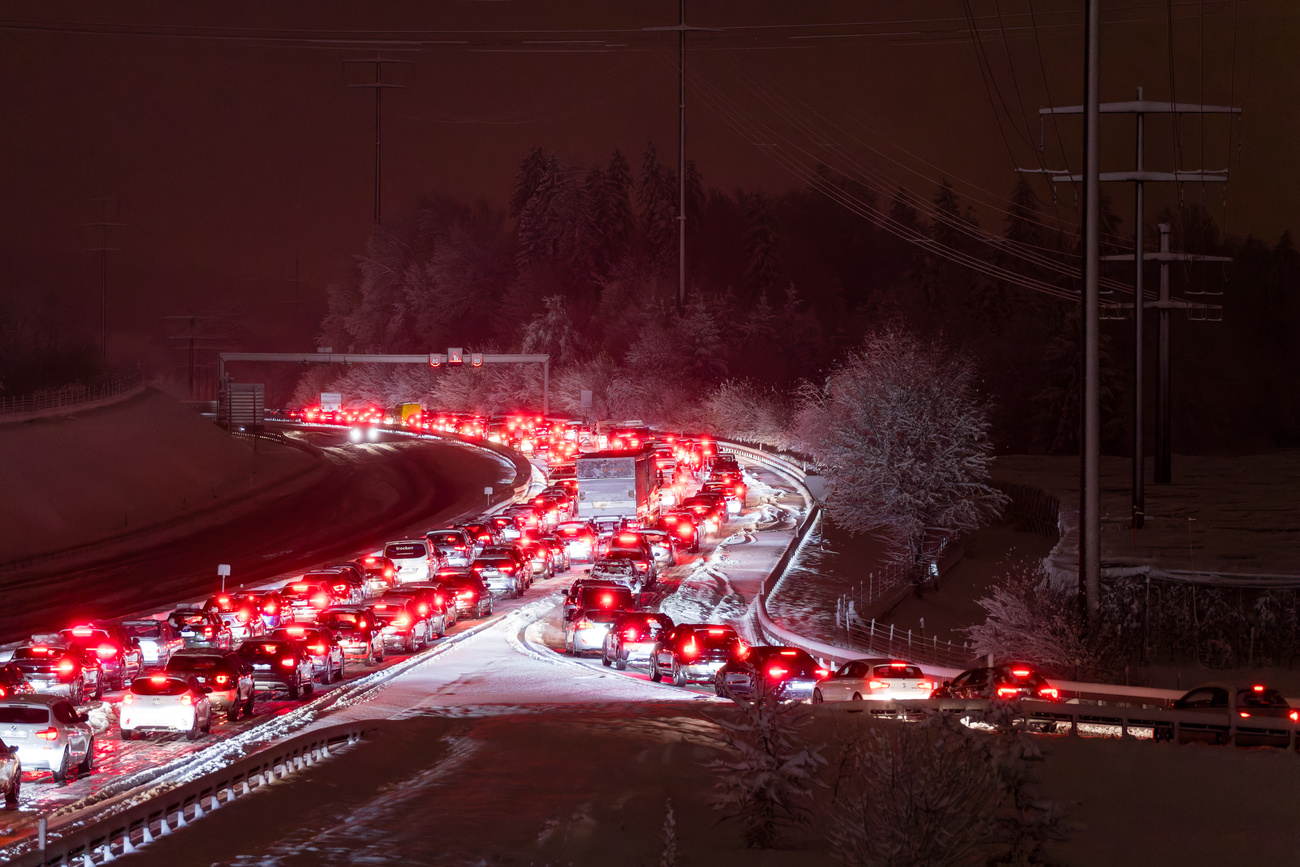Indian motorbike a hit with Swiss ‘silver riders’

Manufactured in India since 1957, the Royal Enfield motorcycle is now targeted at affluent, young bikers. In Switzerland however, its vintage looks and relaxing ride endear it to older bikers who want to recreate a “golden era”.
It’s a sunny Sunday morning in Herisau, the capital of the small rural canton of Appenzell Ausser Rhoden. The sleepy silence at the train station is suddenly shattered by the roar of motorcycle engines.
The intruders are not to be feared. They are ordinary, grey-haired riders on vintage-looking motorcycles with “Royal Enfield” etched on the fuel tank.
They’re members of the Royal Enfield Club of SwitzerlandExternal link and the Herisau railway station is the starting point of their group ride. The trip will take them through the rolling hills of rural Appenzell to the eastern edge of Austria where they’ll stop to visit an exhibition of classic motorcycles. The club is the only one of its kind in the country even if its older members are not the target of the manufacturer’s overseas marketing strategy.
Royal Enfield makes around 300,000 bikes every year at its factory in southern India and mainly targets the “young adult” consumer group in India with money to spend. In 2014, it exported more than 6000 bikes, an increase of almost 50% over 2013. It’s not doing too badly in Switzerland either.
“Last year we sold around 90 Enfield bikes as a distributor and around 40 as a dealer,” Alexander Frei, owner of Egli RacingExternal link based in the northern canton of Aargau told swissinfo.ch. “The Swiss market is growing but at a slow rate.”
‘Silver’ bikers
Royal Enfield’s marketing campaignExternal link for its newest bike – a café racer model launched in 2013- is a sign of its ambition to capture the imagination of young bikers overseas.
“Our focus is on fun, classic and sporty models which is accessible to young generation in terms of pricing,” said company CEO Siddhartha Lal in an interviewExternal link with The Economic Times during the launch of the Continental GT café racer model. “We expect Continental GT to re-build the export markets for Royal Enfield.”
But is Royal Enfield missing a trick by only focusing on younger riders abroad?
According to Kassiem Jacobs, a 52-year-old rider with the Swiss club, around two-thirds of Enfield owners in Switzerland are his age or older.
“I wanted to buy a motorbike when I turned 50 but was not interested in a heavy, powerful machine,” he says. “Something I also appreciate with Enfield is that the design has remained the same for 60 years.”

The relative lack of horsepower and classic design appear to be the main reasons why the Royal Enfield is a hit with older Swiss riders.
“With only 27 horsepower it is not as fast as a Japanese bike,” confirms Werner Spitz, sporting a special back-support vest for the long ride. Spitz has been a biker for almost 40 years. “On the other hand, you can cruise along with the traffic and you’re free from the anxiety of overtaking.”
Spitz owns four bikes including a made-in-India Royal Enfield. He was bitten by the Enfield bug on an organised trip in Bhutan.
“After my Bhutan biking trip, I had to restrain myself from buying an Enfield in Switzerland,” he says. “But after three months I just gave up and bought one!”
His two-wheeled treasure cost him CHF9000 ($9385) and is a special Indian-made version for the European market that meets EU emissions and safety norms.
Another biker who succumbed to Enfield charm abroad is Christian Hanselmann, a wiry man with a grey stubble who comes from a small town near Zurich.
“We were backpacking in South India in 1985 and came across these bikes that looked like an old English motorcycle,” he says. “Now I have two of them, including an English-made one from 1948.”
But an Enfield is not just appealing to male eyes. Silvia Grütter, a 51-year-old media consultant from Illnau in canton Zurich is also an Enfield fan. She first rode an Enfield in Goa, India in 1996 and found that it was the ideal vehicle to take her from party to party.
“It is like riding a horse,” she says. “It is very comfortable and relaxing, almost like meditation.”
She acquired her first Enfield in May this year and has already covered over 3000km on her trusty steed. She has also booked an Enfield riding holiday for next year which will take her from Goa to the southern Indian state of Kerala.
Acquired taste
According to some Royal Enfield club members, one can sometimes bag a nice bike for a good price on the internet because some people buy them with the intent to race them but are then disappointed. However, what is regarded as a drawback by the younger generation is an attraction for old timers like Urs Koter. He chose the Royal Enfield because it gives him the same feeling as motorcycles from a past era.
“I have other bikes but choose the Enfield whenever I want a taste of the biking experience from the 1950s or 60s,” Koter says.

And the Enfield can be a very demanding bike in terms of maintenance and repairs – something that might also put off younger bikers.
“For the Indian market the bikes need to be cheap and sometimes they put in low quality parts to save a few bucks,” says Hanselmann. “Either you need to be good at repairing bikes or know of a good mechanic and have enough cash.”
But for some Enfield fans, the niggles are part of the ownership experience. Peter Vildmer, an engineer from Germany, is riding a 60-year-old model for the first time on the Sunday club ride. His wife has come along in her car with enough tools to carry out emergency repairs in case of a breakdown. But Vildmer thinks the latest models are more reliable.
Motorcycle dealer Frei believes that Enfield’s sportier models like Continental GT café racer coupled with strong marketing abroad will eventually make the brand more attractive to young adults in Switzerland.
“The competitive pricing and beginner-friendly models make it more accessible to younger people than some of the other bikes on the market,” he says.
Rarity is another added bonus, especially for those looking for something different. Royal Enfields are still an unusual sight on Swiss roads compared to Harley Davidsons, Triumphs or Japanese motorcycle brands.
“When I stop at the red light people lower their car windows and give me a thumbs up sign,” says Grütter. “People want to know more about the bike.”
Even Harley Davidson riders, who generally look down at other bikes, are curious about Enfields, according to Jacobs.
“I’ve seen [them] look at our bikes with interest and one of our members was even invited to join them for a part of the ride, which is quite an honour.”
Royal Enfield boasts of being the “oldest continuously-produced motorcycle in the world.” The Enfield manufacturing company was created in 1891 in Redditch, England and first supplied precision rifle parts to the Royal Small Arms factory in Enfield.
The company built its first motorcycle in 1901 but only made an impact on the global motoring stage in 1909 when it introduced a small motorcycle with a Motosacoche engine of Swiss origin.
Enfield India was formed in 1955 in order to meet the demand for a large government order of 800 motorcycles for the Indian police. Initially, Enfield India only assembled the 350cc Bullet motorcycle model but started full-fledged production in 1957. Production ceased in the UK factory in 1970 and the company was dissolved a year later. Enfield India continued manufacturing Bullet bikes and its current stable of 11 bikesExternal link still includes three Bullet models.

In compliance with the JTI standards
More: SWI swissinfo.ch certified by the Journalism Trust Initiative











You can find an overview of ongoing debates with our journalists here . Please join us!
If you want to start a conversation about a topic raised in this article or want to report factual errors, email us at english@swissinfo.ch.